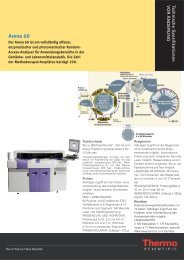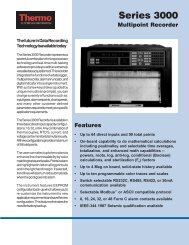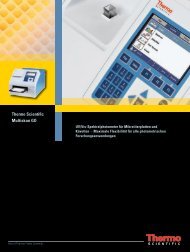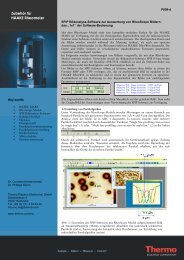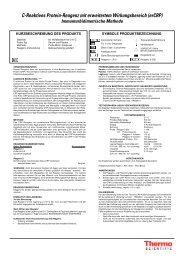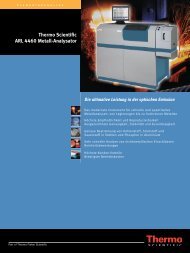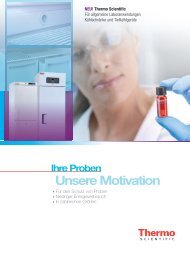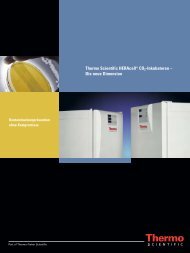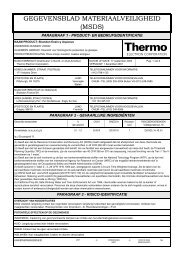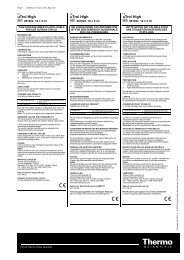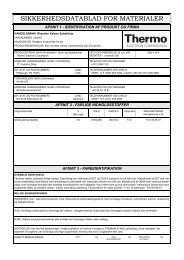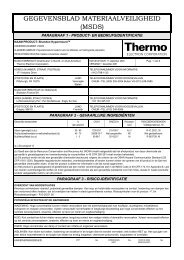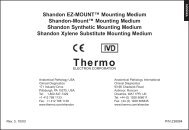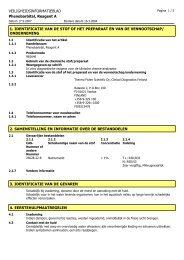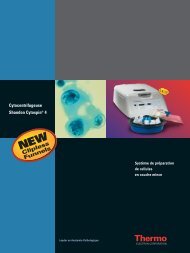Download Full Article [PDF 745 kB] - Thermo Scientific
Download Full Article [PDF 745 kB] - Thermo Scientific
Download Full Article [PDF 745 kB] - Thermo Scientific
Create successful ePaper yourself
Turn your PDF publications into a flip-book with our unique Google optimized e-Paper software.
Application<br />
Note: 30162<br />
Key Words<br />
• Exactive <br />
• Accurate Mass<br />
• High Resolution<br />
• Polarity<br />
Switching<br />
• Scan Speed<br />
The <strong>Thermo</strong> <strong>Scientific</strong> Exactive Benchtop<br />
LC/MS Orbitrap Mass Spectrometer<br />
Andreas Wieghaus, Alexander Makarov, Ulf Froehlich, Markus Kellmann, Eduard Denisov, Oliver Lange,<br />
<strong>Thermo</strong> Fisher <strong>Scientific</strong>, Bremen, Germany<br />
Overview<br />
Review of a new benchtop mass spectrometer based on<br />
a stand-alone <strong>Thermo</strong> <strong>Scientific</strong> Orbitrap mass analyzer.<br />
Key features of the instrument layout, analytical<br />
parameters and typical applications are described.<br />
Introduction<br />
Over the past three years the combination of Orbitrap<br />
technology with a linear ion trap has become an<br />
established platform for high resolution, accurate mass<br />
LC/MS n analysis. The high resolving power, mass accuracy<br />
and dynamic range of the Orbitrap analyzer allow<br />
rigorous characterization of complex mixtures even in the<br />
absence of precursor ion mass selection. We now describe<br />
the development of a non-hybrid mass spectrometer<br />
comprising of an atmospheric-pressure ion source (API)<br />
and a standalone Orbitrap mass analyzer.<br />
Methods<br />
All experiments were performed on a prototype of the<br />
new <strong>Thermo</strong> <strong>Scientific</strong> Exactive mass spectrometer using<br />
an electrospray ionization (ESI) source.<br />
Instrument Layout Overview<br />
Figure 1 shows the schematic layout of the instrument.<br />
Samples can be introduced introduced into the API source<br />
by a variety of methods includingdirect infusion or an<br />
U-HPLC system (<strong>Thermo</strong> <strong>Scientific</strong> Accela ).<br />
The source is similar to the commercial source of the<br />
<strong>Thermo</strong> <strong>Scientific</strong> TSQ Quantum Ultra .<br />
Figure 1: Schematic layout of the instrument.<br />
Ions are transferred from the source through four<br />
stages of differential pumping using RF-only multipoles<br />
into a curved RF-only trapping quadrupole (the C-trap).<br />
In the C-trap ions are accumulated and their energy<br />
dampened using a bath gas (nitrogen). Ions are then<br />
injected through three further stages of differential<br />
pumping using a curved lens system into the Orbitrap<br />
analyzer where mass spectra are acquired via image<br />
current detection. The vacuum inside the Orbitrap mass<br />
analyzer is maintained below 1E-09 mBar.<br />
Automatic Gain Control (AGC)<br />
Automatic control of the number of ions in the Orbitrap<br />
is performed by measuring the total ion charge using<br />
a pre-scan and by calculating the ion injection time for the<br />
analytical scan from this. For very high scan rates, the<br />
previous analytical scan is used as a prescan to optimize<br />
the scan cycle time without compromising automatic gain<br />
control. Ion gating is performed using a fast split lens<br />
setup that ensures the precise determination of the ion<br />
injection time.<br />
Higher Energy Collision Induced Dissociation (HCD)<br />
In a HCD experiment ions are passed through the C-trap<br />
into a multipole collision cell where they are fragmented.<br />
After that, the HCD cell voltages are ramped and ions are<br />
transferred back into the C-trap from where they are<br />
injected into the Orbitrap for detection.
Results<br />
Automatic Gain Control (AGC)<br />
A requirement of any ion trap device is the ability to<br />
control the ion population within the trap. When the ion<br />
population is not accurately maintained it can result in<br />
large variations in the quality of data. The correct AGC<br />
functionality of the Exactive instrument is exemplified in<br />
Figure 2 by two mass spectra acquired in the middle and<br />
at the end of an eluting LC peak of Buspirone.<br />
Scan Speed<br />
The use of a single mass analyzer with very high transmission<br />
characteristics in combination with the use of fast<br />
digital and analog electronics allow high resolution<br />
mass spectra to be detected, processed and recorded at<br />
Figure 2: LC peak and mass spectra of Buspirone acquired at a scan rate of 10 scans per second.<br />
Mass Resolution<br />
At a scan rate of 10 Hz the resolving power of the<br />
instrument is > 10,000 at m/z 200. Increasing the transient<br />
detection time by a factor of 10 (corresponding to a scan<br />
rate of 1 Hz) the mass resolution can be increased<br />
beyond 100,000.<br />
Relative Abundance<br />
100<br />
80<br />
60<br />
40<br />
20<br />
0<br />
169.00880<br />
R=124400<br />
199.05530<br />
R=114600<br />
276.06339<br />
R=97300<br />
245.04321<br />
R=101600<br />
291.07571<br />
R=94800<br />
313.05768<br />
R=89900<br />
417.08408<br />
R=77900<br />
445.11548<br />
R=75400<br />
150 200 250 300 350 400<br />
m/z<br />
450 500 550 600<br />
In both cases the mass resolution, mass accuracy and<br />
signal-to-noise ratio are excellent. The AGC feature in<br />
combination with the precise determination of the ion<br />
injection time allows the instrument to be used for<br />
accurate quantitative analyses.<br />
high scan rates of up to 10 Hz. This is compatible with<br />
the narrow peak widths observed in fast chromatography<br />
analyses (Figure 2).<br />
To demonstrate the resolving power of the instrument<br />
a pesticide mixture was measured showing well resolved<br />
isobaric peaks of Dimethon (m/z 231.0273) and Asulam<br />
(m/z 231.0434) within a full scan spectrum (Figure 3).<br />
551.11932<br />
R=68300<br />
603.12616<br />
R=64200<br />
Figure 3: <strong>Full</strong> scan spectrum of a pesticide mixture demonstrating a resolving power of up to 100,000.<br />
Relative Abundance<br />
100<br />
90<br />
80<br />
70<br />
60<br />
50<br />
40<br />
30<br />
20<br />
10<br />
0<br />
231.02757<br />
R=104600<br />
C6H16O3PS2 1.18536 ppm<br />
231.04359<br />
R=106400<br />
C8H11O4N2S 0.82379 ppm<br />
231.02 231.03 231.04 231.05<br />
m/z
Mass Accuracy and Stability<br />
Using fully automated AGC and mass calibration<br />
procedures, mass spectra with high mass accuracy are<br />
recorded. The mass accuracy, precision and stability is<br />
equally as good as that obtained in ion trap based hybrid<br />
instruments, i.e. <strong>Thermo</strong> <strong>Scientific</strong> LTQ Orbitrap or<br />
LTQ FT Ultra .<br />
deviation (ppm)<br />
deviation (ppm)<br />
3<br />
2<br />
1<br />
0<br />
-1<br />
-2<br />
-3<br />
3<br />
2<br />
1<br />
0<br />
-1<br />
-2<br />
-3<br />
m/z 195 RMS error: 0.45 ppm<br />
0 30 60 90 120 150<br />
time (min)<br />
m/z 524 RMS error: 0.45 ppm<br />
Figure 4 shows the mass accuracy and its stability<br />
over time for different molecular ions of an ESI<br />
calibration mixture. The full scan spectra were acquired at<br />
a resolution setting of 100,000 in an infusion experiment<br />
applying an external calibration, i.e. no lock masses were<br />
used.<br />
deviation (ppm)<br />
3<br />
2<br />
1<br />
0<br />
-1<br />
-2<br />
-3<br />
m/z 1122 RMS error: 0.48 ppm<br />
0 30 60 90 120 150<br />
time (min)<br />
m/z 1722 RMS error: 0.63 ppm<br />
0 30 60 90 120 150<br />
0 30 60 90 120 150<br />
time (min)<br />
time (min)<br />
Figure 4: Mass accuracy and stability of ions at different m/z values acquired in an infusion experiment without using lock masses.<br />
Fast Polarity Switching<br />
Due to the use of a novel power supply design it is<br />
possible to perform fast polarity switching without<br />
sacrificing mass accuracy in any scans. Figure 5<br />
demonstrates this feature by means of two experiments.<br />
In the first experiment the polarity was changed from scan<br />
to scan to check mass accuracy at fast alternating polarity<br />
Figure 5: Mass deviations of m/z 524 (positive ions) and m/z 514 (negative ions) observed in polarity switching experiments.<br />
deviation (ppm)<br />
3<br />
2<br />
1<br />
0<br />
-1<br />
-2<br />
-3<br />
switching corresponding to a full cycle of 1 positive and<br />
1 negative scan within 1 second. In the second experiment<br />
the polarity was switched every 5 minutes to check for<br />
potential drift effects. In both cases full scan spectra were<br />
acquired at a resolution setting of 30,000 in an infusion<br />
experiment using an ESI calibration solution applying an<br />
external calibration, i.e. no lock masses were used.
Dynamic Range<br />
The dynamic range of the instrument varies by sample and<br />
with the instrument settings but it is typically about 3 to<br />
4 orders of magnitude. Figure 6 shows that it is possible<br />
to acquire full scan spectra with an in-scan dynamic range<br />
of more than 13,000. The spectrum was acquired in an<br />
infusion experiment using a mix of Buspirone (m/z 386)<br />
and Caffeine (m/z 195).<br />
All Ion Fragmentation (HCD)<br />
The instrument design allows high efficiency “All Ion<br />
Fragmentation“ experiments by means of Higher Energy<br />
Collision Induced Dissociation (HCD).<br />
100<br />
80<br />
60<br />
40<br />
20<br />
0<br />
100<br />
80<br />
60<br />
40<br />
20<br />
0<br />
1.3 ppm<br />
1.4 ppm<br />
1.2 ppm<br />
303.2071<br />
The ratio of the Buspirone signal to the Caffeine<br />
signal is greater than 13,000. Both peaks show mass<br />
accuracies of less than 1 ppm. Thus this spectrum<br />
demonstrates not only the high in-scan dynamic range in<br />
terms of signal but also the high dynamic range in terms<br />
of mass accuracy of this instrument – analogous to the<br />
performance of a hybrid LTQ Orbitrap mass spectrometer.<br />
Figure 6: Spectrum of a mixture of Buspirone (m/z 386) and Caffeine (m/z 195) showing an in-scan dynamic range of > 13,000 and sub-ppm mass accuracies.<br />
167.0126<br />
165.0912<br />
+<br />
O<br />
O<br />
239.1614<br />
O<br />
O<br />
N<br />
260.1642<br />
O<br />
O<br />
+<br />
311.2189<br />
As an example, Figure 7 shows full scan spectra of<br />
Verapamil with and without HCD fragmentation and<br />
demonstrates the high fragmentation efficiency and the<br />
excellent mass accuracy of the HCD fragments.<br />
150 200 250 300 350 400 450<br />
m/z<br />
Figure 7: <strong>Full</strong> scan spectra of Verapamil with and without HCD fragmentation.<br />
N<br />
N<br />
+<br />
HCD off<br />
HCD on<br />
455.2890<br />
MH +<br />
2.1 ppm<br />
455.2895
Applications<br />
As a result of the described performance characteristics<br />
of this new benchtop Orbitrap mass spectrometer several<br />
key applications are ideally suited to the use of the<br />
Exactive mass spectrometer. Some of these are:<br />
1. Exact mass measurements of organic compounds<br />
2. Early drug discovery metabolism and pharmacokinetics<br />
(DMPK)<br />
3. General unknown screening<br />
4. Multiple residue analysis (Pesticides, Mycotoxins,<br />
veterinary drugs)<br />
5. Metabolomics<br />
For all of these applications high resolution, accurate<br />
mass measurements together with high dynamic range is<br />
required for unequivocal results in full MS mode. Where it<br />
is needed, additional information, can be provided by use<br />
of by high resolution/high mass accuracy MS/MS<br />
experiments in an “All Ion Fragmentation“ mode. Figure<br />
8 shows an extracted ion chromatogram of 116 pesticides<br />
and mycotoxins at a level of 50 ppb in a very complex<br />
matrix of horse feed extract at a mass resolution of<br />
50,000. This exemplifies the high selectivity and sensitivity<br />
of the instrument working in full scan mode, which is<br />
a prerequisite for a successful screening approach, since<br />
resolving matrix interferences from the target analytes is<br />
essential.<br />
Figure 8: Extracted ion chromatogram of 116 pesticides and mycotoxins at a level of 50 ppb in a complex<br />
matrix of horse feed extract.<br />
Conclusions<br />
A new benchtop mass spectrometer has been developed<br />
based on an API ion source combined with a stand-alone<br />
Orbitrap mass analyzer. The key performance features<br />
are as follows:<br />
• Mass resolutions of up to 100,000<br />
• Scan speeds of up to 10 Hz<br />
• High in-scan dynamic range (4 orders of magnitude)<br />
• Mass accuracies of better than 2 ppm in full scan and<br />
“All Ion Fragmentation“ mode<br />
• Fast polarity switching (full cycle of 1 positive and 1<br />
negative scan within 1 second)<br />
• High efficiency “All Ion Fragmentation“ Higher Energy<br />
Collision Induced Dissociation (HCD)<br />
The instrument is very easy to operate and with its<br />
performance characteristics are ideally suited for discovery<br />
work, screening applications, quantitative analyses and<br />
elemental composition determinations.<br />
Acknowledgements<br />
We would like to thank the other Exactive project team<br />
members Frank Czemper, Florian Grosse-Coosmann,<br />
Thomas Heise, Oliver Hengelbrock, Sebastian<br />
Kanngiesser, Alexander Kholomeev, Sascha Moehring,<br />
Uwe Rickens, Ronald Seedorf and Stevan Horning.
Laboratory Solutions Backed by Worldwide Service and Support<br />
Tap our expertise throughout the life of your instrument. <strong>Thermo</strong> <strong>Scientific</strong> Services<br />
extends its support throughout our worldwide network of highly trained and certified<br />
engineers who are experts in laboratory technologies and applications. Put our team<br />
of experts to work for you in a range of disciplines – from system installation, training<br />
and technical support, to complete asset management and regulatory compliance<br />
consulting. Improve your productivity and lower the cost of instrument ownership<br />
through our product support services. Maximize uptime while eliminating the<br />
uncontrollable cost of unplanned maintenance and repairs. When it’s time to<br />
enhance your system, we also offer certified parts and a range of accessories and<br />
consumables suited to your application.<br />
To learn more about our products and comprehensive service offerings,<br />
visit us at www.thermo.com.<br />
Legal Notices<br />
©2008 <strong>Thermo</strong> Fisher <strong>Scientific</strong> Inc. All rights reserved. All trademarks are the property of <strong>Thermo</strong> Fisher <strong>Scientific</strong> Inc. and its subsidiaries. This information<br />
is presented as an example of the capabilities of <strong>Thermo</strong> Fisher <strong>Scientific</strong> Inc. products. It is not intended to encourage use of these products in any manners<br />
that might infringe the intellectual property rights of others. Specifications, terms and pricing are subject to change. Not all products are available in all<br />
countries. Please consult your local sales representative for details.<br />
View additional <strong>Thermo</strong> <strong>Scientific</strong> LC/MS application notes at: www.thermo.com/appnotes<br />
Part of <strong>Thermo</strong> Fisher <strong>Scientific</strong><br />
In addition to these<br />
offices, <strong>Thermo</strong> Fisher<br />
<strong>Scientific</strong> maintains<br />
a network of representative<br />
organizations<br />
throughout the world.<br />
Africa<br />
+43 1 333 5034 127<br />
Australia<br />
+61 2 8844 9500<br />
Austria<br />
+43 1 333 50340<br />
Belgium<br />
+32 2 482 30 30<br />
Canada<br />
+1 800 530 8447<br />
China<br />
+86 10 8419 3588<br />
Denmark<br />
+45 70 23 62 60<br />
Europe-Other<br />
+43 1 333 5034 127<br />
France<br />
+33 1 60 92 48 00<br />
Germany<br />
+49 6103 408 1014<br />
India<br />
+91 22 6742 9434<br />
Italy<br />
+39 02 950 591<br />
Japan<br />
+81 45 453 9100<br />
Latin America<br />
+1 608 276 5659<br />
Middle East<br />
+43 1 333 5034 127<br />
Netherlands<br />
+31 76 579 55 55<br />
South Africa<br />
+27 11 570 1840<br />
Spain<br />
+34 914 845 965<br />
Sweden / Norway/<br />
Finland<br />
+46 8 556 468 00<br />
Switzerland<br />
+41 61 48784 00<br />
UK<br />
+44 1442 233555<br />
USA<br />
+1 800 532 4752<br />
www.thermo.com<br />
<strong>Thermo</strong> Fisher <strong>Scientific</strong><br />
(Bremen) GmbH is certified<br />
DIN EN ISO 9001:2000<br />
AN30162_E 07/08C


![Download Full Article [PDF 745 kB] - Thermo Scientific](https://img.yumpu.com/8952066/1/500x640/download-full-article-pdf-745-kb-thermo-scientific.jpg)
